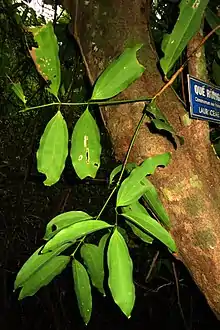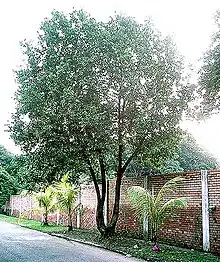| Cinnamomum iners | |
|---|---|
 | |
| Trunk and leaves of specimen tree in Cat Tien National Park | |
 | |
| Tree in Malaysia | |
| Scientific classification | |
| Kingdom: | Plantae |
| Clade: | Tracheophytes |
| Clade: | Angiosperms |
| Clade: | Magnoliids |
| Order: | Laurales |
| Family: | Lauraceae |
| Genus: | Cinnamomum |
| Species: | C. iners |
| Binomial name | |
| Cinnamomum iners | |
| Synonyms[2] | |
| |
Cinnamomum iners[3] is a tree species in the family Lauraceae[4] described by Reinwardt and Blume.[5][6] No subspecies are listed in the Catalogue of Life.[5] It occurs naturally in Myanmar, Thailand, Laos, Cambodia, Vietnam, Malaysia, Indonesia, Brunei, Singapore, the Philippines and southern China.[1]
In Malay C. iners is called pokok medang teja; in Vietnamese it may be called: quế rừng, quế giả, quế lá to, quế lợn, hậu phác, or hậu phác nam.
Description
Cinnamomum iners is an evergreen tree growing up to 20 m in height; the branches have opposite twigs, robust and angular, sometimes tetragonal, glabrescent. Leaves are subopposed, ovate to elliptic, measuring 120–350 mm long and 60–85 mm broad. They are glabrous and the base of the leaf is wedge-shaped with a blunt apex (see illustrations); petioles are more or less pubescent, have a reddish brown colour and 10–30 mm in length. Flowers small and bisexual, pubescent, grouped in axillary or terminal panicles; these inflorescences are 60–260 mm in length. Fruits are ovoid in shape, typically 10 mm long and 7 mm in width. Trees bloom and start to bear fruit from March to June.[7]
Habitat
This species grows in moist woods and thickets, up to 1000 metres elevation.[7]
Gallery
 Drawing of C. iners by J.C.P. Arckenhausen, ~1835
Drawing of C. iners by J.C.P. Arckenhausen, ~1835_6.jpg.webp)
_bark.jpg.webp)
References
- 1 2 de Kok, R. (2019). "Cinnamomum iners". IUCN Red List of Threatened Species. 2019: e.T62020057A62020059. Retrieved 2 February 2023.
- ↑ "Cinnamomum iners Reinw. ex Blume". The Plant List. Retrieved 13 March 2017.
- ↑ Reinw. ex Bl., 1826 In: Bijdr. 570
- ↑ "Angiosperm Phylogeny Website". 2016. Retrieved 13 March 2017.
- 1 2 Roskov Y.; Kunze T.; Orrell T.; Abucay L.; Paglinawan L.; Culham A.; Bailly N.; Kirk P.; Bourgoin T.; Baillargeon G.; Decock W.; De Wever A. (2014). Didžiulis V. (ed.). "Species 2000 & ITIS Catalogue of Life: 2014 Annual Checklist". Species 2000: Reading, UK. Retrieved 26 May 2014.
- ↑ World Plants: Synonymic Checklists of the Vascular Plants of the World
- 1 2 "Cinnamomum iners". Plantes & botanique. Retrieved 16 May 2016.
